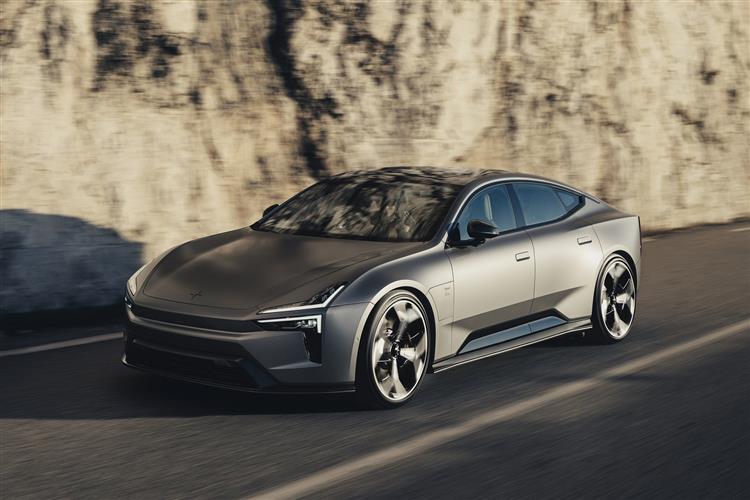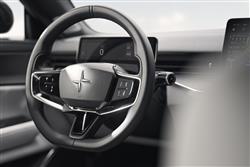FIVE LIVE (some text hidden) --NONE--
By Jonathan Crouch
The Polestar 5 is perhaps the most unique luxury sporting EV we've seen yet. Jonathan Crouch takes a look.
Ten Second Reviewword count: 48
Could this be, for the time being anyway, be the ultimate all-electric luxury car? The Polestar 5 sets out to re-imagine what a high performance Grand Touring four-seat sporting EV can be - and does so in a more bespoke, exclusive, driver-focused way than any of its rivals.
Backgroundword count: 317
Few engineers ever get to work on a project quite like that of the Polestar 5. Clean sheet design. Dedicated architecture. Few cost constraints. Innovation encouraged and fundamental. This is the Sino-Scandinavian EV brand's most ambitious car yet. As the name suggests, it's the fifth model along in Polestar's development, but in reality it's a replacement for the company's original halo model, the Polestar 1. That car was a big PHEV coupe; this one is an even bigger four-door EV GT but the two cars share the same target market and were designed by the same stylist, former Polestar CEO Thomas Ingenlath. Ingenlath oversaw much of this 5 model's troubled and over-lengthy development, following its origins way back in 2019 as a styling concept named the Precept. The project then hit one snag after another, with the battery chemistry changed halfway through the programme (rendering much of the powertrain development useless). Then, just weeks before the overall design had to be locked in, Ingenlath himself insisted on wheelbase shortening, forcing whole sections of the car into a re-design. Unlike other Polestars, which platform-share with other models overseen by parent company Geely, the 5 gets its own unique platform, a super-stiff bonded extruded aluminium chassis. It's a sort of thing we've seen on hand-built sports cars over the years, most notably Lotus models. Since Lotus is also part of the Geely Group and sells a direct luxury GT four-door competitor to the Polestar 5, the Emeya, you'd think the two brands would have collaborated. Instead, Polestar went its own way, creating bespoke underpinnings that (for the time being) will only be shared with their forthcoming Polestar 6 luxury roadster EV. The core target market here is the Porsche Taycan and its clone, the Audi e-tron GT - in a segment at around the £100,000 price point which has lately shrunk alarmingly. Can Polestar really make this product work?
Engines and Tech Specword count: 384
What kind of driving experience could a car like this offer if you engineered it from a completely clean sheet with nothing borrowed from anything else? Only the Polestar 5 can claim such a CV in this class, with a totally bespoke bonded extruded aluminium chassis (the Polestar Performance Architecture) developed in the UK by team of mainly British engineers experienced in creating generations of English sports cars. From launch, the choice was between two flavours of twin motor (so AWD) EV drivetrain (with a single motor variant planned for the future). Only the rear motor is Polestar-developed (the rear motor is from ZF) and everything is energised by a big 112kWh battery. The base Dual Motor version is all you really need, with 737bhp. Which is 147bhp up on a rival Porsche Taycan S, though the 3.9s 0-62mph time is much the same. Range is 416 miles, 16 up on the Porsche. Most '5' customers though, will probably find the extra for the top Performance model, which offers a huge 871bhp. That's the same as a Taycan Turbo, but the 3.2s 0-62mph time is half a second down on that Porsche and the EV range figure of 351 miles is 40 miles less. In terms of drive dynamics, the unique engineering of this Polestar ought to compensate for any statistical deficits, but at first glance at the spec sheet, you might start to wonder about that. Few of the technical toys you might expect from a six-figure sports GT seem to be present. There's no rear-wheel steering, torque vectoring or limited-slip differential. The Taycan's clever two-speed transmission isn't replicated. There's no air suspension (the bags for it would have ruined the low front bonnet line) and you only get adaptive damping (the magnetorheological kind) if you opt for the top Performance model. From then on though, things get better. You sit low on the lovely Recaro-designed seats and the uniquely developed rear view mirror screen allows you to quickly forget about the lack of a rear window. Expect the exceptional rigidity of that bespoke chassis design to deliver class leading handling, aided by sharp steering and bespoke Michelin Pilot Sport tyres. The result is perhaps the car maybe you'd hoped a Lotus Emeya would be. Perhaps with the Lotus-like underpinnings here, that's appropriate.
To see the full road test text contact us on 0330 0020 227
Pictures (high res disabled)

.jpg)
|
.jpg)
|
.jpg)
| |||
.jpg)
|
.jpg)
|
.jpg)
| |||
.jpg)
|
.jpg)
|

|
Statistics (subset of data only)
Min |
Max |
|
Price: |
£89,500.00 (At 19 Sep 2025) |
£104,900.00 (At 19 Sep 2025) |
Max Speed (mph): |
155 (Performance) |
|
0-62 mph (s): |
3.1 (Performance) |
|
Electric WLTP-Rated Driving Range (miles): |
351 |
|
Length (mm): |
5087 |
|
Width (mm): |
2015 |
|
Height (mm): |
1425 |
|
Boot Capacity (l): |
365 |
|



